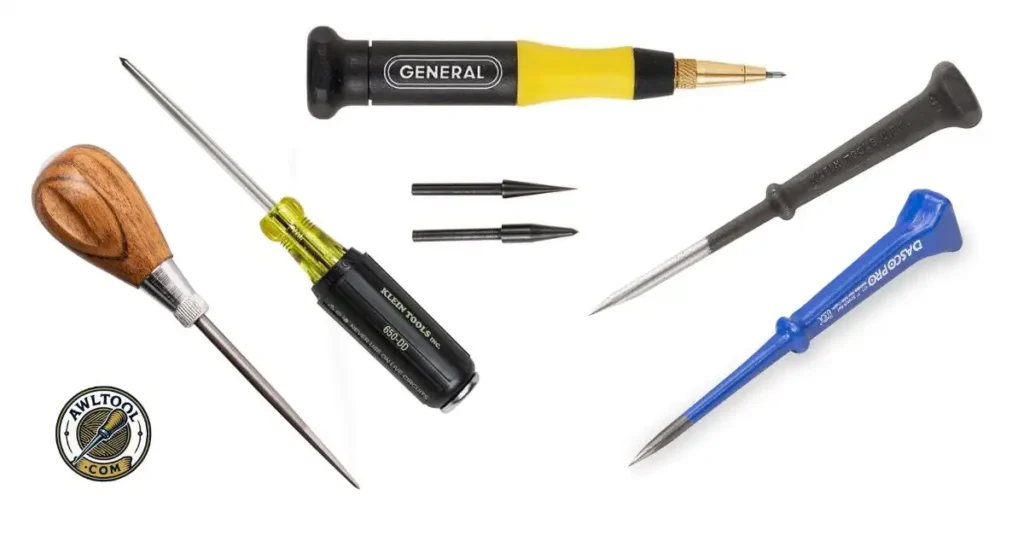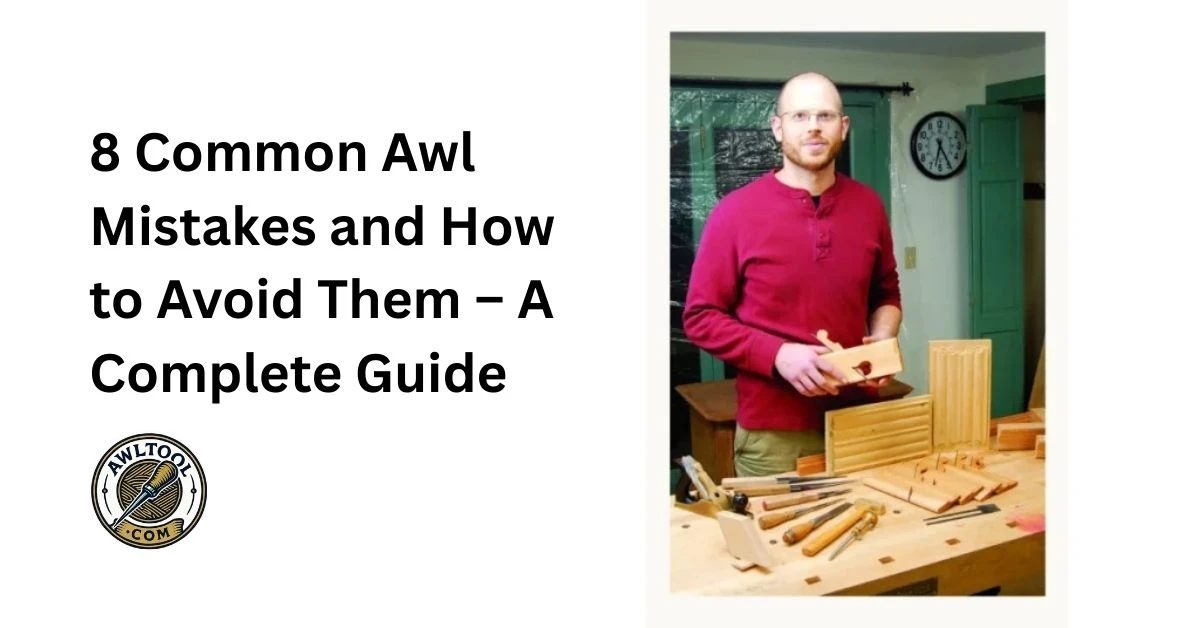This guide covers the 8 Common Awl Mistakes and How to Avoid Them and how to avoid them. With the right approach, you’ll achieve cleaner results, extend the life of your tools, and make your craft more enjoyable.
| Mistake | Problem | Fix |
|---|---|---|
| 1. Holes Too Large | Weak stitches, unprofessional look | Make small, precise holes |
| 2. Dull Awl | Slips, tearing, uneven holes | Keep awl sharp |
| 3. Wrong Angle | Uneven/flat stitches | Hold blade parallel to edge |
| 4. Too Much Force | Damaged leather or tool | Use steady pressure / mallet |
| 5. Surface Damage | Scratches or gouges | Stabilize leather, control grip |
| 6. Wrong Awl Type | Inconsistent results | Match awl to task |
| 7. Poor Maintenance | Rust, dull tips, loose handle | Clean & sharpen regularly |
| 8. Ignoring Ergonomics | Hand strain, fatigue | Use comfy handle, take breaks |
Join the Community on Instagram and Facebook: Share your favorite marking or drilling tools and tag us to get featured!
Table of Contents
Why Using an Awl Correctly Matters

An awl isn’t just “a sharp point on a handle.” It’s a precision tool. A properly used awl helps you:
- Create consistent, professional stitching holes in leather.
- Pierce materials cleanly without tearing or fraying.
- Maintain alignment for durable, symmetrical seams.
- Work faster with less strain when sharp and properly angled.
But small mistakes, like choosing the wrong awl or failing to sharpen it—can quickly ruin hours of work. Let’s go through the pitfalls to avoid.
8 Common Awl Mistakes and How to Avoid Them
1. Making Holes Too Large
Mistake: Many assume that bigger holes make stitching easier. In reality, oversized holes weaken the material, distort stitches, and look unprofessional.
How to Avoid It:
- Use the smallest hole possible that still allows the needle and thread to pass.
- For leatherwork, keep holes snug so the thread sits firmly without wobbling.
- Practice on scrap material before working on your main project.
💡 Pro Tip: A diamond awl naturally creates angled slits rather than round holes—this helps lock stitches more securely than oversized punctures.
2. Using a Dull Awl
Mistake: Forcing a dull awl through material is dangerous. It requires more pressure, which can cause the tool to slip, tear your project, or even injure your hand.
How to Avoid It:
- Keep your awl sharp at all times.
- Use a whetstone, fine-grit sandpaper, or honing rod to restore the tip.
- Store your awl with a protective cap to prevent blunting.
💡 Pro Tip: A sharp awl should glide with minimal force. If you’re struggling, it’s not your strength—it’s your tool.
3. Incorrect Diamond Awl Alignment
Mistake: Twisting or rotating a diamond awl creates flat or unevenly shaped holes. This leads to crooked stitches and weak seams.
How to Avoid It:
- Hold the awl with the flat side of the diamond blade parallel to the edge of your material.
- Keep your wrist steady; let the blade do the work.
- Check alignment every few stitches to maintain consistency.
💡 Pro Tip: Use a stitching chisel or pricking iron to mark hole spacing, then pierce with the awl for perfectly aligned results.
4. Scratching or Damaging the Surface
Mistake: Poor control can cause the awl to slip, leaving scratches or gouges on the surface of your leather or fabric.
How to Avoid It:
- Work on a stable, flat surface.
- Hold the awl firmly, but without excessive tension.
- Use clamps or weights to secure your material before piercing.
💡 Pro Tip: If you scratch leather accidentally, you can sometimes buff it gently with a bone folder to reduce visible marks.
5. Applying Too Much Force
Mistake: Over-pressing can split leather, punch through unintended layers, or even snap your awl.
How to Avoid It:
- Test on scrap leather first to gauge pressure.
- For thick hides, lightly tap the awl with a mallet rather than forcing it.
- Always let the sharpness of the awl do the work—not brute strength.
6. Using the Wrong Type of Awl
Mistake: Not all awls are the same. Using a scratch awl for stitching or a diamond awl for marking lines leads to poor results.
How to Avoid It:
- Diamond awl: Stitching holes.
- Scratch awl: Marking guidelines or tracing patterns.
- Bladed awl: Cutting or enlarging holes.
- Sewing awl (with thread): Heavy-duty stitching repairs.
💡 Pro Tip: Keep a labeled toolkit so you can quickly grab the right awl for the job.
7. Neglecting Tool Maintenance
Mistake: Dull tips, rusted steel, or loose handles reduce precision and can ruin your project.
How to Avoid It:
- Sharpen regularly.
- Wipe down after every use to prevent rust.
- Store in a dry place, ideally in a protective roll or sheath.
- Check handles for cracks or looseness.
8. Ignoring Ergonomics
Mistake: Long awl sessions can strain your hands, wrists, and shoulders, especially if your awl has a poorly shaped handle.
How to Avoid It:
- Choose awls with ergonomic handles designed for comfort.
- Adjust your work surface to a comfortable height.
- Take breaks every 30 minutes to reduce fatigue.
💡 Pro Tip: Padded gloves or handle grips can reduce strain during long leathercraft sessions.
Awl Tool Safety Checklist
☑ Cut-resistant gloves
☑ Safety glasses
☑ Leather apron
☑ Clamp or stitching pony
☑ First-aid kit within reach
☑ Cork or sheath on unused awls
☑ Monthly ferrule check reminder
Final Thoughts
Avoiding these mistakes will instantly improve your awl work. To recap:
- Make small, precise holes (not oversized).
- Keep your awl sharp and well-maintained.
- Master diamond awl alignment for even stitching.
- Prevent scratches by controlling grip and stabilizing your material.
- Use the right awl for each task.
- Respect ergonomics for long-term comfort.
By practicing proper technique and maintaining your tools, you’ll save time, prevent frustration, and produce work that looks clean and professional. Remember—small details make the biggest difference in craftsmanship.
How to maintain a stabbing awl and stamping tools:
Speedy Stitcher Troubleshoot:
Best Awl tools Short lists by job categories:
- Awl Tool Kit for Beginners
- Best awl tool for Woodworking
- Best awl tool for leatherworking
- Best awl tool for Bookbinding
- Best awl tool for Tailoring
- Best awl tool for Crafting
- Unique Applications (Carpet awl, Plastic, Bone)



